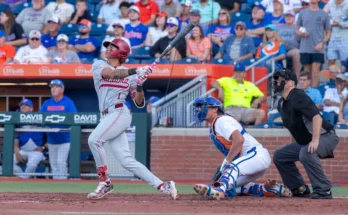“This Isn’t College Basketball Anymore”: How Revenue and the Transfer Portal Are Killing Traditional Recruiting — “It’s Business Now, Not Just Scholarships” as NIL Deals Reshape the Game
College basketball, once rooted in regional pride, tradition, and player development, has entered an era few foresaw just a decade ago. What used to be a slow and sacred cycle of recruiting high school players, nurturing their talent over several seasons, and watching them graduate into adulthood has given way to a fast-paced, transactional ecosystem dominated by two words that have transformed the sport’s DNA: revenue and mobility. Coaches across the country are sounding the alarm, athletic directors are reworking budgets, and fans are struggling to reconcile what they see on the floor with what they once loved. The soul of the sport hasn’t disappeared—but it’s been repackaged, monetized, and redistributed in ways that would have been unimaginable a generation ago. And it’s largely because of the sudden and seismic collision between Name, Image, and Likeness (NIL) money and the NCAA’s newly unrestricted transfer portal.
It used to be that the dream of a Division I scholarship drove much of the recruitment energy. Coaches would identify players as freshmen or sophomores in high school, nurture relationships with families, and watch them compete through AAU seasons. They’d bring them in for campus visits, sell them on facilities, academics, and culture. Some coaches would even pride themselves on never offering a transfer, believing loyalty and development were worth more than quick fixes. But those days are over. The transfer portal, introduced to increase player autonomy, has rapidly devolved into a kind of collegiate free agency, where loyalty often depends on dollars, minutes, or exposure.
Now, recruiting isn’t just about 17-year-olds with dreams—it’s about 20-year-olds with leverage. Mid-major stars flirt with Power Five schools for NIL promises. Benchwarmers on high-profile rosters look for more minutes at lower-tier programs. And blue-chip freshmen who don’t see the court immediately? They’re gone in April. Coaches must now constantly re-recruit their own rosters, ward off tampering from rival programs, and scour the portal not for role players but for instant-impact stars. The portal, in conjunction with NIL collectives, has created an incentive structure that rewards movement over loyalty, production over potential, and short-term gain over long-term development.
Take, for example, the case of a mid-major All-Conference guard who entered the portal in March. Within 48 hours, his phone had buzzed with offers from five major conference schools, all hinting at NIL opportunities that dwarfed what his current school could offer. One Power Five program didn’t even hide the transaction—an assistant coach mentioned a six-figure figure before even asking about his fit. A few years ago, this would’ve been a recruiting violation. Today, it’s the norm. There are compliance loopholes, of course, and many programs use third-party collectives to maintain plausible deniability. But make no mistake: recruiting in college basketball is no longer about the pitch; it’s about the package.
The new reality is that high school recruiting is drying up for all but the most elite prospects. Coaches used to fill 80–90% of their roster through high schoolers. Now, some D-I programs sign just one or two freshmen per year, preferring the reliability and maturity of transfers. It’s not that high school talent has declined—it’s that uncertainty has become a liability. Why gamble on a four-star recruit who might not pan out or might transfer after one year when you can get a proven 22-year-old with three years of college experience? Even blue bloods are adjusting. One prominent head coach recently admitted that his staff devotes more time scouting the portal than the AAU circuit. Another simply said, “The portal is where you win now.”
That reality has created a Darwinian arms race among programs. Those with deep pockets—either through alumni, donors, or athletic department resources—can weaponize NIL in ways others can’t. Schools that once had to rely on tradition or coaching acumen now compete on cash. It’s not always public, but it’s understood. When a transfer announces his commitment to a school with no obvious regional ties or playing time advantage, insiders shrug. Everyone knows what’s behind it: a collective offer too good to pass up. NIL has not only changed the destination—it’s changed the motive.
In turn, the relationship between coaches and players has become more delicate. Coaches once commanded control over a roster for four years. They could mold young men, instill discipline, and build a system. Now, coaches must operate like NBA GMs—managing egos, contracts, and movement. The fear of losing a player looms constantly. A tough conversation about playing time could lead to an exit. A star player who’s underpaid relative to his production? He might be gone next year. Loyalty, once the cornerstone of college coaching, is now a luxury.
For players, the upside is freedom and financial empowerment. Many athletes who once left college broke now earn enough to support their families, build savings, or launch brands. That’s progress. The problem isn’t the players taking advantage of a new system—it’s the system itself, which was built hastily, with no real regulation, no salary cap, and no oversight. The NCAA opened Pandora’s box when it lost its grip on amateurism, but failed to build guardrails. The result is a Wild West landscape where rules change by the hour and ethics are optional.
Fans, too, are feeling the impact. Attachment to players used to last years. Now, rosters flip every spring. The star you rooted for last season might be suiting up for a conference rival this fall. Jersey sales and NIL autographs are outdated within months. For older fans, the identity crisis is real. College basketball was supposed to be about the journey—watching a player grow from freshman jitters to senior leadership. That narrative is harder to find now. It still exists in pockets—programs like Gonzaga or Villanova still try to develop—but even they are not immune to the pressure.
There’s also the question of fairness. Smaller programs are often treated like farm systems for the rich. A mid-major that discovers and develops a gem rarely gets to enjoy the fruits of that labor. After one breakout season, the star enters the portal and lands at a higher-profile school with more money. It’s demoralizing for coaches, devastating for fanbases, and destabilizing for the sport. The trickle-up system rewards those who already have, and punishes those trying to build.
And yet, in this chaos, there is clarity: college basketball has fully embraced its professional identity. What used to be an amateur proving ground is now a marketplace. Players are assets. Coaches are brokers. Schools are brands. There are winners and losers, just like any business. The game on the floor is still compelling, but what happens off the floor may be even more important now. Who your coach is matters. But who your donors are might matter more.
This isn’t to say that the game is doomed. College basketball still produces thrilling moments, emotional victories, and incredible athletes. March Madness remains a cultural phenomenon. And there are players who stay loyal, build legacies, and represent their schools with pride. But they are now the exception, not the rule. The days of building dynasties through patience, culture, and development are fading. In their place are short-term rentals, NIL negotiations, and roster churn.
Some suggest that the solution lies in regulation—either from the NCAA or, more likely, Congress. Ideas like revenue sharing, player unions, NIL transparency, and transfer limits have been floated. But for now, change moves faster than legislation. The NCAA, battered by legal defeats and public pressure, has lost the authority to control its own ecosystem. Until a new governing structure emerges, chaos will continue to rule.
Ultimately, the story of modern college basketball is one of transformation. The traditions that built the sport—four-year players, long-term recruiting pipelines, regional pride—have been replaced by new paradigms. It’s a new game with new rules. Some mourn the change. Others embrace it. But everyone agrees on one thing: this isn’t college basketball anymore.



